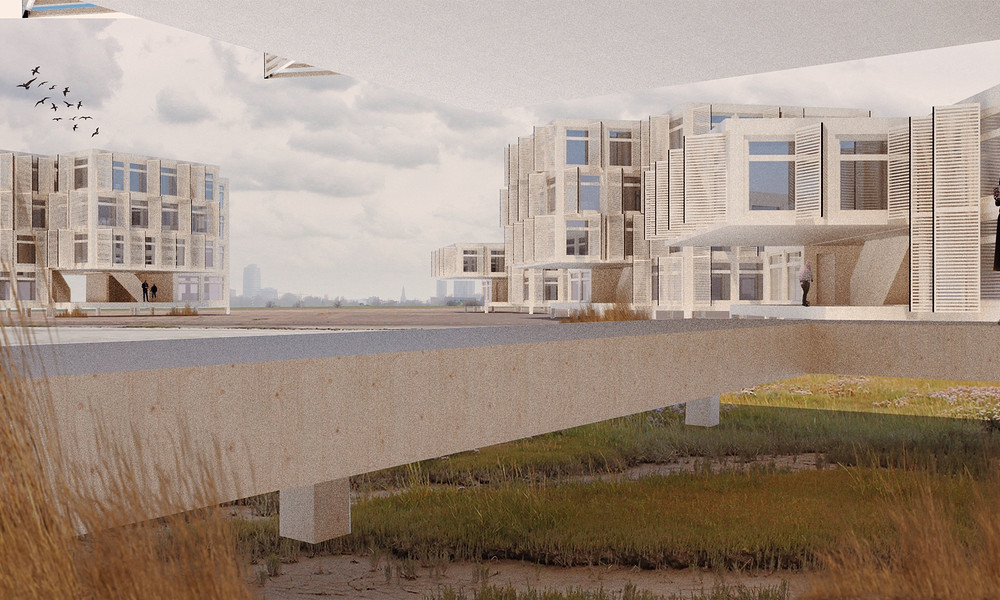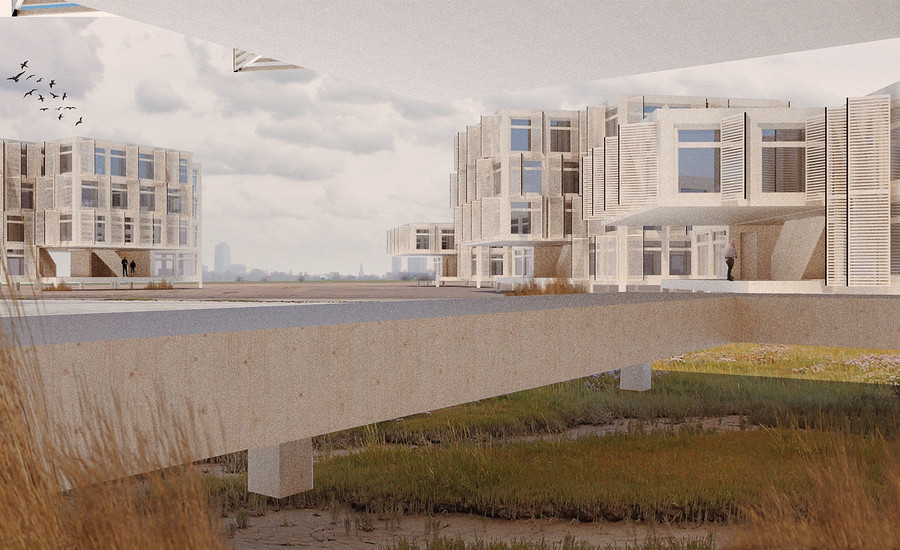Thomas Wehkamp designed 'Folqaborg, the Future of Zernike'
- News

Just imagine: the year is 2200, the sea level has risen seven meters, the Wadden Sea has reached the city of Groningen. What would Zernike Campus look like? Thomas Wehkamp is one of the students of the Master Architecture who is coming up with solutions to keep our feet dry in Groningen in the future. 'I don't want to go against nature, but move with nature.'
Groningen, especially the city, lies on the border between lowland and highland. With the Wadden Sea on one side and the Hondsrug on the other', Thomas explains. The assignment to the first-year students at the Master Architecture was: design student housing on Zernike Campus and make it climate-adaptive, resistant to extreme weather as a result of climate change. 'So it wasn't about the educational buildings, but about student housing. Although I interpreted this more broadly, by also designing houses for the elderly and families, because designing just for students does not fit my narrative.'
Thomas describes what the landscape surrounding Groningen around 2200 would look like if we do not continue to raise the dikes endlessly. 'The province of Groningen will be a kind of bathtub that empties and fills up at low and high tide. The Wadden landscape will reach as far as the city. Zernike Campus is located on the edge of that high-low area. My solution for housing lies in the past, when people lived on ‘wierden’ – that's what mounds in Groningen are called. Back then they also dealt with a landscape that was prone to flooding. Folqaborg, the name of my design, is a reference to the old name of the village of Dorkwerd, next to Zernike. In my design, people live in communities on modern mounds.'
The research that preceded the design, was conducted by the master students in groups. The students worked with the results individually. Thomas' source of inspiration was a small river near Geneva, the Aire, which found its own way again through a pattern of diagonal lines. 'Nature got a kind of starting signal there and the river started meandering again. I find the principle of giving nature a starting signal and then letting it find its own way extremely interesting. I took the shape and language of that river as a starting point for the mounds. With the housing on top of it.'
Thomas designed six buildings, all made of sustainable materials. He not only took into account developments in the future, his building materials are also in line with them. 'A certain type of oak can withstand salt water better than other trees', Thomas explains. 'They can grow on the mounds. The insulation comes from reeds from the area. The complex forms a square on the edge of the mound, with low-rise apartments for three students or duplex apartments where a family could live. The cascading building stands on stilts, creating natural vertical ventilation. The underpass forms a jetty at high tide. A kind of Venetian island so that the complex remains accessible at all times.'
Thomas' design transcends the current situation because he has assumed that the world will look completely different in 2200. 'My position is: you can defend yourself endlessly against the water, but does that make sense? In the Netherlands we have a wonderful tradition of going against the water. We realise more and more that it is disastrous for the quality of our landscape. The soil is subsiding and our water management is not in order. The land that has compacted can be raised because sediment is deposited by ebb and flow, so by letting nature take its course. In 300 or 400 years, people will be able to live there again. Whereas if you keep raising the dikes, the Groningen bathtub will only get deeper and deeper. I don't want to go against nature, but move with nature. Let us adapt as human beings. Our ideas to solve the problems of Groningen can be just as big as those of the people who thought of pumping out the Zuiderzee. Solutions that are state-of-the-art, but that can also bring people closer to nature.'

How satisfied are you with the information on this page?